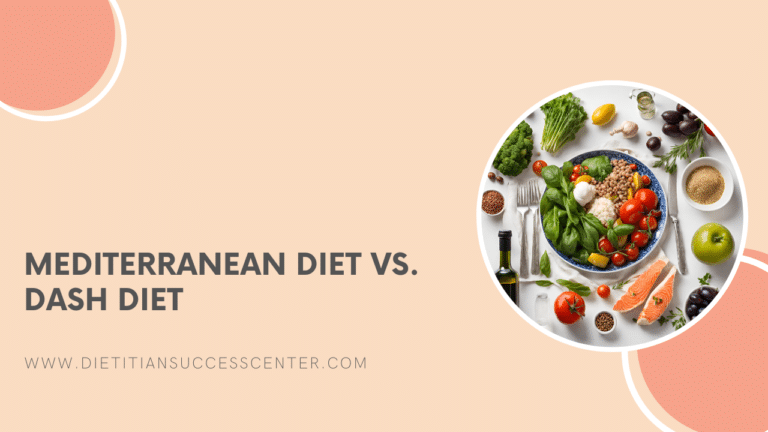

Written by Olivia Farrow, RD, MHSc
Reviewed by Maria Dellanina, RDN
Whether you are a student, dietetic intern, new dietitian, or seasoned dietitian you might be feeling stuck with nutrition diagnosis and PES statements. We’re here to help – with a practical breakdown of the steps involved in a nutrition diagnosis example and PES statement!
Quick Links
What is a Nutrition Diagnosis?
Your nutrition diagnosis is part of the nutrition care process (NCP) that is added right after the assessment and before the intervention. It consists of your PES statement – a structured sentence in your chart note that communicates your nutrition diagnosis using the problem, etiology, signs and symptoms you observe as a nutrition professional.
The nutrition diagnosis takes all that you have learned about the client from your assessment and designates a main nutritional “problem” (or diagnosis) that you will be addressing.
Now, a nutrition diagnosis is not the same as a medical diagnosis. It is very important not to confuse the two.
The nutrition diagnosis is the issue that you as the nutrition professional are going to address, such as inadequate intake of a certain nutrient. It is not a medical diagnosis such as diabetes or celiac disease, which would require a medical doctor to diagnose.
How to Write a PES Statement
PES statements communicate the nutrition-related problem that can be improved or resolved by nutrition intervention. They help to summarize your nutrition assessment and give justification for the next steps of the nutrition intervention.
A PES statement has three components:
P: Problem – What is the main nutrition-related issue? (Must be a specific phrase from the Nutrition Care Process Diagnostic Terminology)
E: Etiology – What is the etiology (the root cause or origin) of the problem that can be addressed (or signs and symptoms lessened) by nutrition intervention?
S: Signs and symptoms – How do you know the problem is happening? What evidence do you have that the etiology is the root cause of the problem? What will you monitor to assess your intervention?
These sections are combined in a structured sentence by the phrases “related to” and “as evidenced by,” as shown below:
The PROBLEM related to ETIOLOGY as evidenced by SIGNS and SYMPTOMS.
Your PES statement nutrition diagnosis can help you prioritize the main nutritional concern and focus on what you, as the nutrition professional, can actually address.
Learn more about how to write PES Statements in this blog article and get your free PES Statements Cheat Sheet, with 23 pages of example PES statement pieces that you can mix and match to build your nutrition diagnosis.
Now that you know how to write your PES statement, let’s get into our Nutrition Diagnosis example!
Remember, you want to design your own nutrition diagnosis based on your unique client’s assessment and nutritional needs. This is a simplified example for the purpose of explaining the nutrition diagnosis process and is not intended to be used for your clients.
Nutrition Diagnosis Example

Case Study
- Your client is Mr.Blue, a 50 year old male who was diagnosed with diabetes 6 months ago.
- You are meeting with him for the first time in an outpatient setting.
- His most recent hemoglobin A1c has increased since his diagnosis, his most recent was 8.9%.
- He takes metformin twice daily.
- His weight is 195 lbs and height is 5’10”.
From your first meeting and initial assessment, you learn that Mr.Blue has never received formal diabetes nutrition education or nutrition counseling. He was told by his doctor to “eat healthier” to improve his blood glucose. Since his diagnosis, in an effort to control his glucose levels, he began to attempt eating a “no-carb diet” based on some information he found online.
Diet Recall: He skips breakfast, has a “carb-free” lunch (typically romaine lettuce with chicken or tuna added and sugar-free vinaigrette salad dressing), and he has dinner with his family (wife and 2 teen children) which is not “carb-free” and he finds himself eating very large portions of pasta, bread, potato or whichever carbohydrate is available during the meal. He reports that after dinner he “cannot stop himself from eating” and eats several different foods including a large bowl of corn flake cereal with milk, 5-10 cookies, and 2-3 chocolate granola bars.
Mr.Blue expresses to you that he wants you to help him with “self-discipline” and “making a list of meals his wife can prepare that are carb-free.”
From your assessment, you determine that the main problems Mr.Blue is experiencing include:
- Limited understanding of diet for diabetes, despite a clear motivation to make changes.
- Erratic timing of meals and carbohydrate intake.
- A low intake of fiber and low-glycemic index carbohydrates, compared with high-glycemic index ones.
- No formal diabetes nutrition education and has made diet changes based on information found on the internet.
There are several possibilities for nutrition diagnosis here, let’s walk through the steps to create our PES statement.
Problem
Starting with the nutrition problem, which needs to be:
- A specific nutrition diagnosis term.
- Addressed with nutrition intervention.
Some possible nutrition problems might include:
- Excessive carbohydrate intake – Addresses the issue of Mr.Blue’s excessive carbohydrate consumption in the evenings but does not address the issue of restricting carbohydrates during the day.
- Intake of types of carbohydrate inconsistent with needs – Addresses the fact that intervention may include discussing high-fiber, low-glycemic index carbohydrates, but does not address the restriction and subsequent overconsumption of carbohydrates.
- Inconsistent carbohydrate intake – Addresses the inconsistent timing of carbohydrate intake including restriction during the day and subsequent overconsumption in the evening.
- Limited food and nutrition related knowledge (Food and Nutrition Knowledge Deficit) – Addresses Mr.Blue’s limited understanding of recommended dietary choices for diabetes but is non-specific to the main nutrition related problem, which relates more to carbohydrate choices. Further, this diagnosis is from the “Behavioral-Environmental” diagnosis domain and it is preferable to focus on a problem that is within the “Intake” diagnosis domain whenever possible.
- Altered nutrition-related laboratory values (HbA1c) – Does not address the nutrition issues occurring and is not specific to nutrition intervention.
For this case, the main nutrition problem that we can best address is: Inconsistent carbohydrate intake. |
Etiology
For etiology, we’re looking at the main root cause of the problem of Mr.Blue’s “inconsistent carbohydrate intake.” This is what follows “related to…” in our PES statement.
To sort out the root cause, let’s first break down the possible contributing factors that are leading to Mr.Blue’s erratic carbohydrate eating pattern. This might include:
- His limited knowledge regarding diet for diabetes including regular meals with consistent carbohydrate spacing.
- The belief that he needs to completely avoid carbs to improve his diabetes.
- Skipping breakfast and avoiding carbohydrates at lunch.
- His large portion sizes of carbohydrate foods at dinner.
- Snacking on large volumes of low fiber, high glycemic index carbohydrate foods after dinner.
Any one of these could be used to form the etiology for our PES statement, but we want to focus on which one could be addressed with our intervention that could also help to address some or all of the others.
In this scenario, Mr.Blue’s limited knowledge of diabetes nutrition could be the main root cause behind his inconsistent carbohydrate intake. By addressing this etiology with our intervention, with education and nutrition counseling, we can also address his belief that he needs to avoid carbohydrates, his meal skipping and carb avoidance at lunch, his carbohydrate portions at dinner, and his choices of evening snacks.
Our PES statement becomes: Inconsistent carbohydrate intake related to limited food and nutrition related knowledge concerning appropriate carbohydrate intake … |
Signs and Symptoms
Lastly, we document our signs and symptoms. Signs and symptoms tell us: how do we know that the problem and etiology are true?
From our assessment information, the data that tells us that Mr.Blue has inconsistent carbohydrate intake and limited food and nutrition related knowledge concerning diabetes nutrition includes:
- Mr.Blue’s direct reports of trying to “follow a no-carb diet” while also struggling with “can’t stop himself from eating” and thinking it is a problem of “self-discipline.”
- Mr.Blue’s diet recall which shows evidence of carb restriction followed by excessive carb intake.
- Mr.Blue’s lack of formal diabetes-related nutrition education and nutrition counseling.
- Mr.Blue searching online for dietary advice.
- Hemoglobin A1c has increased since his diabetes diagnosis (and attempting the “no-carb” diet) and is elevated at 8.9%.
Our PES statement becomes: Inconsistent carbohydrate intake related to limited food and nutrition related knowledge concerning appropriate carbohydrate intake as evidenced by diet recall showing erratic carbohydrate eating pattern, client report of restriction and subsequent excessive consumption of carbohydrate foods, elevated HbA1C of 8.9%. |
Now that we’ve got our nutrition diagnosis example, we can move on to our intervention to target Mr.Blue’s inconsistent carbohydrate timing and his knowledge of appropriate carbohydrate intake.

Key Takeaways
- Nutrition diagnosis is the step that follows the nutrition assessment and uses a structured sentence, a PES statement, to communicate the diagnosis.
- The nutrition diagnosis compiles the main problem the client or patient is facing related to their nutritional intake, the root cause of the problem that will be addressed with nutrition intervention, and the evidence of the problem and contributing factors.
- The nutrition diagnosis should be specific to your unique client/patient and their individualized needs, health goals, and intervention requirements.
If you’re looking for more practical information on implementing the nutrition care process, check out these other free resources below:
Blog: How to Write a PES Statement
Blog: How to Use the NCP & ADIME in Practice
Blog: Nutrition Assessment Forms: What to Include?
Free PES Statement Cheat Sheet
For more case study based nutrition diagnosis examples on many topics – join DSC today! Share this with a friend, colleague, or student who would love to learn more about nutrition diagnosis through real-life examples. Let’s spread the knowledge together!








